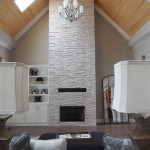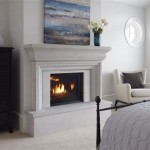Best Colour To Paint A Brick Fireplace: A Comprehensive Guide
Painting a brick fireplace can dramatically alter the aesthetic of a room, transforming it from rustic and traditional to modern and contemporary. However, choosing the right colour for this project is paramount. The colour selection process involves careful consideration of existing décor, desired mood, and the architectural style of the house. This article will delve into the various colour options available, providing a detailed explanation of their impact and suitability for different scenarios, ensuring an informed decision-making process.
Understanding Undertones: Foundation for Colour Selection
The concept of undertones is crucial when selecting a paint colour. Undertones are the subtle hues beneath the primary colour, which can influence how the paint appears in different lighting conditions. For example, a seemingly neutral grey may have blue, green, or even pink undertones. Ignoring these undertones can result in a colour that clashes with existing elements in the room. To identify undertones, compare the paint sample to a pure white sheet of paper under various lighting conditions – natural daylight, incandescent light, and fluorescent light. This comparative assessment will reveal the underlying hues that may otherwise be hidden.
Cool undertones, prevalent in blues, greens, and purples, can create a calming and serene atmosphere. These colours are well-suited for rooms that receive ample sunlight and aim for a relaxed ambiance. Warm undertones, found in yellows, oranges, and reds, evoke feelings of warmth, energy, and vibrancy. These colours are ideal for rooms that lack natural light or seek to create a cozy and inviting space. Neutral colours, such as greys, beiges, and whites, can possess either warm or cool undertones, making them versatile options for various interior designs. Careful consideration of undertones is essential to ensure that the painted fireplace complements the overall aesthetic of the room.
Furthermore, the existing brick itself might have undertones that should be considered. Older brick can sometimes display hints of orange, red, or even brown which can subtly influence the chosen paint colour. Sampling paint directly on the brick is a recommended step before committing to the entire project. This allows for a visual assessment of how the paint interacts with the brick's inherent colour characteristics.
Popular Colour Choices and Their Impact
Several colour options are frequently considered for painting brick fireplaces, each offering a unique aesthetic and contributing to a distinct atmosphere within the room. Exploring these options and their respective impacts is crucial for making an informed decision.
White: White is a classic and versatile choice that brightens up a room and creates a clean, modern aesthetic. It reflects light, making the space feel larger and more open. White is particularly effective in smaller rooms or those with limited natural light. However, it's important to choose the right shade of white. Bright white can feel stark and clinical, while off-white or creamy white offers a warmer and more inviting feel. Consider the existing trim and wall colours when selecting the specific shade of white. A slight contrast between the fireplace and the surrounding walls can add depth and visual interest.
Grey: Grey provides a sophisticated and contemporary look. It is a neutral colour that complements a wide range of décor styles. Like white, grey can enhance the perception of space and create a calming atmosphere. The specific shade of grey can significantly impact the overall feel of the room. Light grey creates a soft and airy ambiance, while darker grey adds drama and sophistication. Consider the undertones of the grey. A grey with warm undertones can soften the coolness of the brick, while a grey with cool undertones can enhance the modern aesthetic.
Black: Black offers a bold and dramatic statement. It can create a striking focal point in a room and add a touch of elegance. Black is particularly effective in larger rooms with high ceilings and ample natural light. However, it should be used sparingly in smaller rooms, as it can make the space feel smaller and more enclosed. Consider the finish of the black paint. A matte finish creates a sophisticated and understated look, while a glossy finish adds a touch of glamour. Black can also be used to highlight architectural details of the fireplace, such as the mantel or hearth.
Beige/Cream: These warm neutrals offer a softer alternative to white and grey. They create a cozy and inviting atmosphere, perfect for rooms that aim for a relaxed and comfortable feel. Beige and cream complement a wide range of décor styles, from traditional to contemporary. They are particularly effective in rooms with natural wood accents or warm-toned furnishings. Consider the undertones of the beige or cream. A beige or cream with warm undertones can enhance the warmth of the room, while a beige or cream with cool undertones can create a more balanced and harmonious feel.
Colour: While neutrals are common choices, using colour to paint a brick fireplace can be a way to create a vibrant and unique space. Deep blues, greens, or even reds can be effectively used to paint brick if the surroundingdecor allows. Always sample the paint before committing to the whole fireplace.
Factors Influencing Colour Choice: Guiding Principles
Several factors should influence the colour choice for a brick fireplace, including the overall décor of the room, the architectural style of the house, and the desired ambiance. Careful consideration of these factors will ensure a cohesive and harmonious aesthetic.
Existing Décor: The colour of the fireplace should complement the existing décor of the room, including the wall colour, furniture, and accessories. Consider the overall style of the room. If the room has a modern aesthetic, a white, grey, or black fireplace may be the most appropriate choice. If the room has a traditional aesthetic, a beige, cream, or muted colour may be more suitable. Consider the colour palette of the room. The fireplace colour should harmonise with the existing colour scheme, creating a cohesive and balanced look. Use colour swatches and samples to compare potential colours against the existing décor. This visual assessment will help determine the best colour to complement the room's overall aesthetic.
Architectural Style: The architectural style of the house can also influence the colour choice. A modern house may benefit from a sleek and minimalist fireplace in white, grey, or black. A traditional house may be better suited for a fireplace in beige, cream, or a muted colour. Consider the existing architectural details of the fireplace, such as the mantel, hearth, and firebox. The colour should complement these details and enhance their visual appeal. If the fireplace has intricate details, a lighter colour may be more appropriate to highlight these details. If the fireplace has a simple design, a bolder colour may be used to create a statement.
Desired Ambiance: The desired ambiance of the room is another important factor to consider. A light and airy room may benefit from a white or light grey fireplace. A cozy and inviting room may be better suited for a beige, cream, or warm-coloured fireplace. A dramatic and sophisticated room may be enhanced by a black or dark grey fireplace. Consider the function of the room. A living room may benefit from a warm and inviting fireplace, while a bedroom may be better suited for a calming and serene fireplace. Consider the lighting in the room. A room with ample natural light can handle darker colours, while a room with limited natural light may benefit from lighter colours.
Brick Texture and Condition: The texture and condition of the brick are also extremely important factors to consider. If the brick is very rough or has a lot of imperfections, a solid colour might highlight these flaws. In this case, consider a paint with a slight texture or a whitewash effect to soften the appearance. If the brick is crumbling or damaged, repairing it before painting is essential for a long lasting look. Painting over damaged brick can lead to further deterioration and an unsatisfactory finish. A porous brick texture will absorb paint differently than a smooth brick surface. Applying multiple thin coats of paint is generally more effective than applying one thick coat, as it allows the paint to penetrate the brick's pores evenly and prevent a blotchy appearance.
Choosing the best paint colour for a brick fireplace requires a holistic approach, incorporating a deep understanding of colour undertones, evaluating popular colour choices based on their inherent impact, and considering the influence of existing décor, architectural style, desired ambiance, and the actual properties of the brick itself. By carefully considering these factors, one can make an informed decision that enhances the aesthetic appeal of the room and creates the desired atmosphere.

The Top Color Ideas For Painting A Brick Fireplace 700 N Cottage

Best Paint Colors For A Painted Fireplace Macfarland Painting

The Best Paint Colors To Go With A Brick Fireplace Red Fireplaces

How To Paint A Brick Fireplace Picking The Best For Your Paintzen

7 Beautiful Ideas For Painting Interior Brick Fireplaces

30 Gorgeous Painted Brick Fireplace Ideas

How To Paint A Brick Fireplace What Use Home With Janny

How To Paint A Brick Fireplace Beamin Moore

ᑕ❶ᑐ How To Paint Your Brick Fireplace For Home

13 Inspiring Colours To Paint Your Brick Fireplace








